Anxiety is a mix of feeling nervous, worried, fearful, and uneasy about an upcoming event or situations—real or imagined. Everyone get anxious from time to time, but some people get anxious so often that it takes over their lives.
For example, a person may feel anxious before going to a dentist appointment or job interview. A person with an anxiety disorder may feel anxious every time they leave home and it affects their ability to interact with others and complete daily activities.
It is not always easy to tell if or when everyday anxiety crosses the line into a disorder. Ask for help at the health centre if you think you have an anxiety disorder —if symptoms of anxiety get in the way of everyday life. For anonymous support, call the Kamatsiaqtut Help Line at 1-800-265-3333.
If you think someone is at risk of harming themselves or others, take them to the health centre immediately or call the RCMP.
Types of Anxiety Disorders
Extreme worry
If a person worries too much about everyday things—large and small—they may be experiencing general anxiety disorder, the broadest type. How much is too much worrying?
- Having persistent anxious thoughts on most days of the week, for six months or more.
- Feeling anxious gets in the way of everyday life and daily activities.
- Having noticeable symptoms, such as fatigue, muscle tension, and problem sleeping.
- Emotions are causing lot of suffering and dysfunction.
Sleep problems
Trouble falling and staying asleep is part of many mental health illness. It is usual for a person to toss and turn the night before an important event, but the person that is always awake and worried—about a specific problem or nothing at all—may have an anxiety disorder.
Unreasonable fears or phobias
Some anxiety is related to a certain thing or situation—such as crowds, flying, or heights. If a person's fear is overpowering, it may be phobia—a type of anxiety disorder. Some phobia's are not obvious. A person may go for years without having to deal with it. For example, if you have a flying phobia, but never get in a plane. Some people have to deal with their phobia everyday.
Chronic indigestion
Anxiety may start in the mind, but symptoms often appear in the body. Irritable bowel syndrome(IBS) includes stomachaches, cramping , bloating, gas, constipation, and/or diarrhea. IBS is not always connected with anxiety, but the two might happen together and make each other worse.
Social anxiety
It is a common to feel self-conscious when meeting new people or doing a presentation. For people with social anxiety disorder, this anxiety is extreme and exists in everyday situations such as one-on-one conversations. People with social anxiety disorder feel like everyone is looking at them. They may blush, tremble, feel nauseous and sweat a lot. Symptoms can be so difficult that they find it hard to meet new people, have a close relationship, or do well at work or school.
Panic
A panic attack is sudden feeling of fear that can last for several minutes. Some people may have a racing heartbeat, trouble breathing, tingling or numb hands, lots of sweat and stomach and chest pain. People that experience regular panic attacks may have an anxiety disorder.
Flashbacks
Reliving a disturbing or traumatic event is a common experience for people with post-traumatic stress disorder (PTSD). Flashbacks can happen with other types of anxiety disorders as well.
Compulsive behaviours
A person with Obsessive Compulsive Disorder(OCD) has repeated, unwanted thoughts that make them feel that they have to do something repetitively, This is called compulsive behaviour. The behaviour may be mental (telling yourself "it'll be all right" over and over again) or physical(hand washing, straightening items, counting, rechecking something that you've already done).
Ways to Manage and Reduce Anxiety
Anxiety is one of the most common mental health problems in the world. Many people find effective ways to manage and reduce anxiety. Here are a few examples:
- Track your mood. When you feel anxious, see if there is a way to identify things that add to your anxiety. Use this knowledge to better understand what causes your anxiety.
- Learn and practice physical and mental relaxation and breathing techniques.
- *Tip: You can YouTube different relaxation and breathing exercises to find one that works best for you.
- Join a support group (in—person or online) for an opportunity to share experiences and coping strategies.
- Avoid alcohol and caffeine if they increase anxiety symptoms.
- Visit a health care provider and make a treatment plan. There are different ways to treat anxiety, and you can find a plan that works for you.
Many people with an anxiety disorder do not know they have a treatable mental health problem. They say they have felt nervous and anxious all their lives. This problem can occur at any age. A person may need a complete medical exam before a doctor can diagnose and treat an anxiety disorder. Often the cause remains unknown.
A person with an anxiety disorder may have other problems such as depression and/or problematic drug/alcohol use or addiction. These can be serious risks factors for suicide. Children with at least one parent with depression are more than twice as likely to have an anxiety disorder. Women are twice as likely as men to have problems with an anxiety disorder.
Ask for help at the health centre if you think you have an anxiety disorder—if symptoms of anxiety get in the way of everyday life. For anonymous support, call the Kamatsiaqtut Help Line at 1-800-265-3333.
If you think someone is at a risk of harming themselves or others, take them to the health centre immediately or call the RCMP.
Visit the Help and Support page to find out about available resources.



